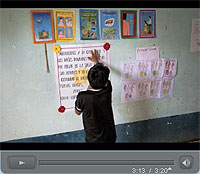Progress Represents a Major Step toward the Goal of Interrupting Transmission of
River Blindness in the Americas by 2012
Note: This press release is from The American Society of Tropical Medicine and Hygiene (ASTMH). See below for additional information.
WASHINGTON, Nov. 21, 2009 – A regional initiative launched in the 1990s to eliminate onchocerciasis (river blindness) in the Americas has substantially reduced the prevalence of the disease in recent years, as evidenced by a 31% decrease in the number of individuals requiring mass drug administration in six endemic countries. Results were reported today at the 58th annual meeting of the American Society of Tropical Medicine and Hygiene (ASTMH).
The reported progress reflects the success of the Onchocerciasis Elimination Program for the Americas (OEPA), which promotes health education and twice-yearly administration of the deworming drug Mectizan® (ivermectin) to more than 85% of the eligible population of endemic communities in six countries. The OEPA was formed in response to a 1991 Pan American Health Organization (PAHO) resolution to stop blindness from onchocerciasis in the Americas by 2007 (later augmented to stop transmission by 2012).
The Carter Center in Atlanta, GA is the sponsoring agency for the Guatemala-based OEPA, a partnership that includes the six endemic countries, Lions Clubs Foundation International, the U.S. Centers for Disease Control and Prevention (CDC), the PAHO (the American regional office of the World Health Organization), and the Bill & Melinda Gates Foundation. Merck & Co., Inc. contributes greatly to the program's achievements by donating supplies of Mectizan for as long as is necessary to eliminate river blindness as a public health problem.
"OEPA is a true success story made possible by the combined efforts of governments, industry, and untold numbers of local people doing field work in extremely difficult conditions," said Frank O. Richards, MD, who directs the River Blindness Program of The Carter Center. "However, we cannot rest on our laurels. Critical work remains to be done to reach our goal of interrupting onchocerciasis transmission in the Americas by 2012."
Onchocerciasis, the world's second leading infectious cause of blindness, is a parasitic disease caused by a roundworm called Onchocerca volvulus. It is transmitted to humans by the bites of tiny black flies that breed in rapidly flowing rivers and streams. The worm enters the body through the skin, under which it matures and reproduces. The offspring, known as microfilariae, migrate under the skin and cause intense itching. Movement of the microfilariae to the eyes can result in worsening vision and blindness. The World Health Organization (WHO) estimates that approximately half a million people worldwide have been blinded by onchocerciasis.
"Opportunities to eliminate any tropical disease, especially on a regional level, are rare and infrequent. The progress reported today by the OEPA is a real milestone," said Thomas Wellems, MD, PhD, president of ASTMH. "Onchocerciasis is a major obstacle to economic growth in many countries, particularly in Africa because it often results in arable land being abandoned out of fear of infestation. By ridding countries of this and other diseases, we will see the world economy improve. Health advances are the foundation for increased prosperity."
In his ASTMH presentation, Dr. Richards referred to a 2008 OEPA report to the PAHO documenting region-wide achievement of semi-annual mass drug administration goals in the six endemic countries (Brazil, Colombia, Ecuador, Guatemala, Mexico, and Venezuela), the elimination of eye disease attributable to onchocerciasis in 9 of the 13 target geographical foci (areas where populations of the parasite intersect with populations of hosts -- including black flies -- that support its existence), and interruption of transmission (with concomitant cessation of mass treatment) in 6 of the 13 foci. No new cases of complete blindness from onchocerciasis have been recorded in the region in the last decade, he noted. In response to the OEPA report, the PAHO Directing Counsel issued a revised resolution calling on countries and their partners to complete the elimination of onchocercal eye disease and interrupt onchocerciasis transmission in the Americas by the end of 2012.
"The Carter Center is leading the elimination campaign efforts by continuing to target the Amazon region of Brazil and Venezuela, the site of all the remaining eye disease and the most active onchocerciasis transmission areas in the Americas," Dr. Richards added. "These areas are extremely difficult to access, and they constitute the greatest hurdle to completing onchocerciasis elimination in this hemisphere. Reaching this goal will require continued focus, technical support, and investment from the program partners."
"The ASTMH is pleased to provide a forum for the presentation of these very encouraging data, which highlight a successful tropical disease elimination program," noted Dr. Wellems. "We look forward to the day when the Onchocerciasis Elimination Program for the Americas announces completion of its work, a milestone that will reflect the combined contributions of governments, industry, and the research and public health communities."
About the ASTMH
The American Society of Tropical Medicine and Hygiene (ASTMH), founded in 1903, is a worldwide organization of scientists, clinicians and program professionals whose mission is to promote global health through the prevention and control of infectious and other diseases that disproportionately afflict the global poor.
About The Carter Center
A not-for-profit, nongovernmental organization, The Carter Center has helped to improve life for people in more than 70 countries by resolving conflicts; advancing democracy, human rights, and economic opportunity; preventing diseases; improving mental health care; and teaching farmers in developing nations to increase crop production. The Carter Center was founded in 1982 by former U.S. President Jimmy Carter and his wife, Rosalynn, in partnership with Emory University, to advance peace and health worldwide. Please visit www.cartercenter.org to learn more about The Carter Center.
###
For additional information contact:
Christina Witz
MWW Group
Phone: 646-509-9379
Email: cwitz@mww.com
Multimedia

Guatemala's Fight Against Onchocerciasis (2009)
Learn more about the Onchocerciasis Elimination Program of the Americas >
Read more about Frank Richards >
Please sign up below for important news about the work of The Carter Center and special event invitations.